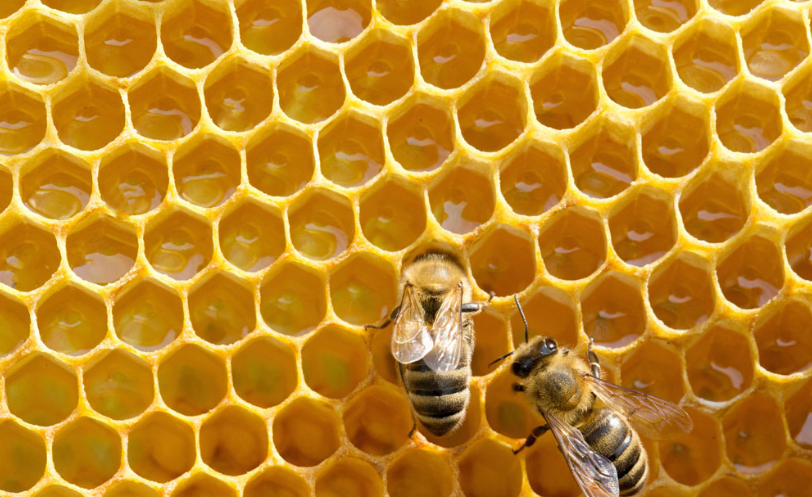- Beehall always with you !
Beeswax is a fatty substance secreted by the wax glands in the abdomen of bees who are about two weeks old in the colony. In bee colonies, worker bees use the wax they secrete to build nest spleens, ovary covers, and feed house covers. The nest spleen is a place for bees to store food, breed bees and roost, so beeswax is both a product of the colony and an essential material for its survival and reproduction.
Only the worker bees in the colony have 4 pairs of wax glands, and the queen and male bees have no wax glands. The wax glands are specialized from the epithelial cells of the body wall and are located on the web of the last 4 segments of the abdomen of the worker bee, with a transparent chitin microscopic membrane on the outside. When wax glands secrete wax, the liquid wax secreted out of it exudes through the cell holes to the mirror membrane, and after contact with air, it condenses into white transparent wax scales. Worker bees poke wax scales with their hind feet, transfer them to their upper jaws through the forefoot, and mix in the secretion of the upper jaw glands by chewing, and become plastic beeswax under the conditions of nest temperature to build a nest house.

The amount of working beeswax is related to the season, climate, day age, and feed. When the bee colony is vigorously reproduced and the external honey powder is continuously collected by the bees into the nest, the enthusiasm for wax production is high. When waxing, the honey sac should first be full of honey, and the honey juice in the honey sac undergoes a series of biochemical changes to become a complex liquid wax secretion.
According to the measurement, the worker bee secretes 1kg of beeswax, which needs to consume more than 3.5kg of honey juice. Young workers have underdeveloped beeswax glands and no ability to make waxes; when they go out to collect bees and the elderly beeswax glands are degenerated, generally no longer secrete wax; the in-house beeswax glands that are only 13-18 days old are developed and have the most wax; the amount of wax secretion is reduced in the cold; and the bees that overwinter and clump do not secrete wax.
Pure beeswax is white, and most of the beeswax seen is light yellow, medium yellow or dark brown, which is caused by fat-soluble carotids or other pigments present in pollen, propolis. At room temperature, beeswax is solid and has a beeswax-scented smell similar to honey and bee pollen. The specific gravity at 20 °C is 0.954-0.964. The melting point varies according to the source and processing extraction method, and is generally between 62-67 °C. At 300 °C, beeswax becomes smoke and decomposes into volatile substances such as carbon dioxide and acetic acid.
Most of the bee wax in the market are a mixture of bee wax, soy wax and other wax, but our bee wax is totally pure that can meet our national standard. We are focusing on organic bee product. Our bee wax can also be used to coat food in order to keep your food fresh. Beeswax can be chewed directly like chewing gum , after chewing the residue can be spit out, can also be used scrambled eggs , the specific method is to first take a small amount of beeswax in a hot pot to melt, and then beat into the egg fried to eat.
The effect of beeswax is mainly antibacterial and anti-inflammatory, derived from the antibacterial ingredients rich in beeswax on a variety of bacteria, viruses and fungi have inhibition and killing effect, while some of the ingredients contained in beeswax have the effect of promoting wound healing, so beeswax in the treatment of trauma such as burns, burns and other aspects have a very significant, in addition to beeswax contains carotids, vitamins and aromatic substances have the effect of nourishing the skin, especially in terms of moisturizing is the most prominent.
Although beeswax can be eaten directly, but when eating must pay attention to the following two problems, one of the beeswax contains a certain amount of allergic substances, allergy constitution may occur after eating allergic reactions, so it is best not to eat beeswax, the second is that beeswax contains a large number of fatty substances that are difficult to digest in the gastrointestinal tract, a small amount of consumption has a regulatory effect on gastrointestinal function, excessive consumption is easy to lead to indigestion, stomach distension and stomach pain.
 Hot News
Hot News2024-01-16
2023-11-28
2023-11-15
2023-10-26
2023-10-16
2023-10-11
 ONLINE
ONLINE